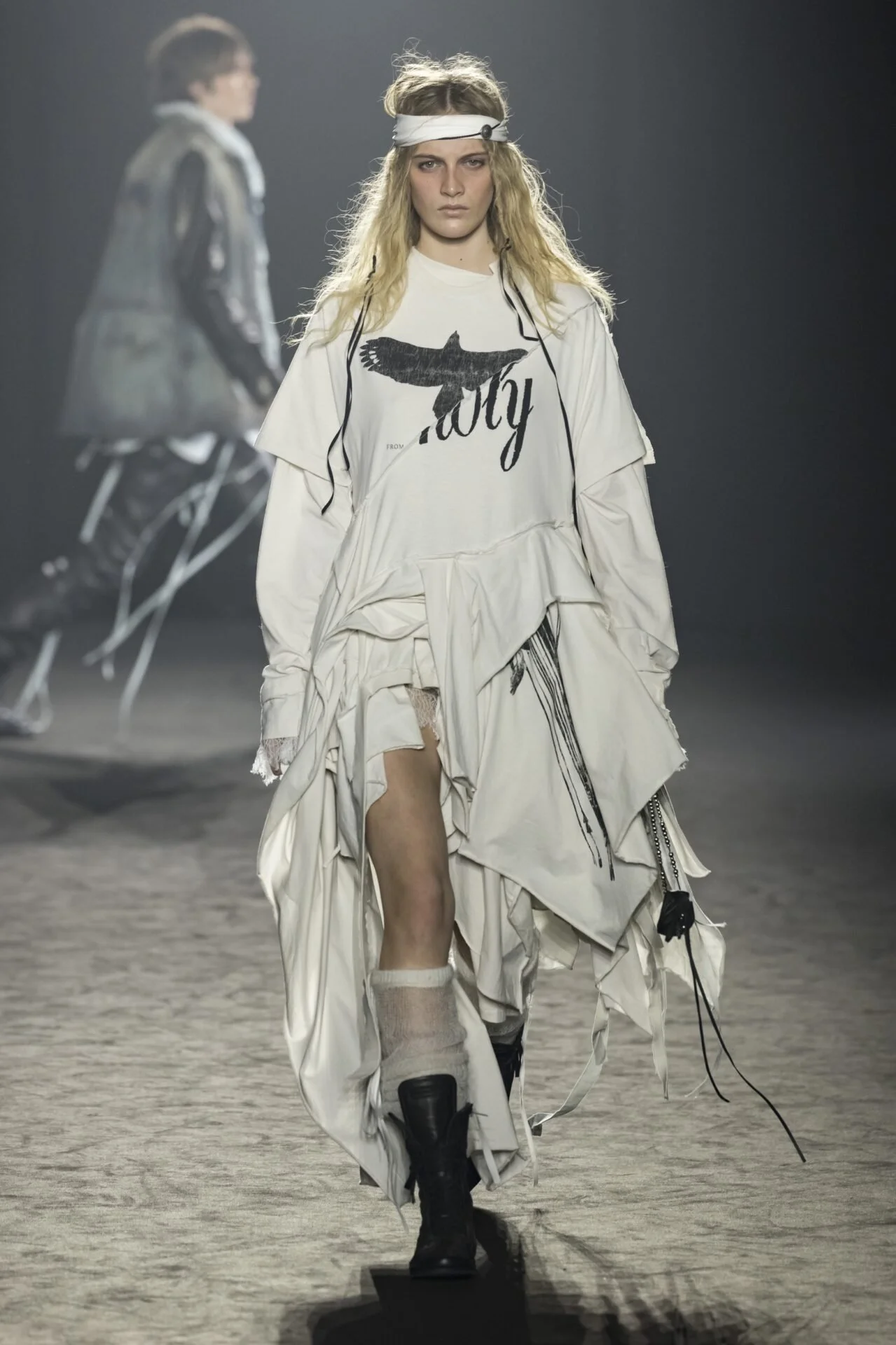A Look into Ann Demeulemeester F/W25
Words by Rachel Hambly
eds. Mistral Zerbi
All eyes have been on the runway recently, as fashion weeks in Milan and Paris have wrapped up, taking over social media feeds and magazine stands. Across the panel, many brands such as Enfants Riches Déprimés and Luis de Javier focused on their dark roots, with all-black looks and gothic references, but no one does it better than Ann Demeulemeester. Their F/W25 show has reimagined gothic interest in fashion, solidifying the brand’s influence and breathing life into the discourse around dark fashion. Known for their avant-garde aesthetics, Ann Demeulemeester has remained a pillar of gothic style since 1985. While the brand has always maintained a loyal audience, this show captured the attention of social media in a way not seen by the brand in years, resonating with both long-time admirers and a younger audience embracing the current dark revival.
The collection embraced a moody, poetic sensibility, with a colour palette dominated by deep blacks, charcoal greys, and muted jewel tones. Silhouettes played with contrasts — billowing coats layered over sharply tailored trousers, delicate lace paired with structured leather corsets, trailing fabric scraps, and flowing graphic tees. One of the standout looks featured a floor-length black velvet coat with exaggerated lapels, worn over a sheer, ruffled blouse and high-waisted leather pants, perfectly encapsulating the tension between elegance and rebellion. Another highlight was a sculptural, off-shoulder gown in distressed silk, evoking a sense of gothic decay and romance. A particularly striking ensemble consisted of a high-neck lace bodysuit under an oversized wool coat, accessorized with leather gloves and knee-high boots, exuding an air of dark sophistication.
The show’s attention to detail extended beyond the garments to the overall ambiance. The soundtrack played a crucial role in heightening this immersive experience, opening with the melancholic strings of Nick Cave and the Bad Seeds, setting a hypnotic tone. As the models glided down the catwalk, the music transitioned into the brooding electronic beats of The Cult, reinforcing the collection’s dark energy. This careful curation of sound and setting transformed the show into more than just a presentation of clothing — it became a theatrical exploration of gothic beauty.
There was also a deeper narrative behind the collection’s aesthetic. Creative Director Stefano Gallici looked to America’s counterculture heritage, drawing on the rebellious spirit of nomads, rockers, and wanderers. “Influences ranged from the free-spirited atmosphere of Woodstock '69 to the darker tones of the Rolling Stones' Altamont Speedway concert, reflecting a balance between light and dark in the collection,” Hero Magazine’s Alex Taylor writes. This duality was shown in the styling, which paired delicate, sheer fabrics with rugged leather and distressed denim, as well as in the mix of Victorian-inspired silhouettes with contemporary, deconstructed tailoring.
Ann Demeulemeester’s ability to stay true to its signature aesthetic while evolving with contemporary fashion is what made this collection particularly successful. Rather than chasing trends, the brand continues to refine its vision, ensuring that gothic fashion remains not just relevant but essential. The use of layering in the collection was particularly striking, with models showcasing asymmetrical draping and unexpected pairings, such as sheer chiffon blouses peeking out from beneath heavy wool coats. Layering has been popular on every runway recently, with Prada’s obsession with sheer skirts over coloured undergarments and cardigans on top of cardigans, as well as Kiko Kostadinov’s use of gloves over hand warmers and vests over turtlenecks. By using trends from across fashion houses, Demeulemeester shows anyone can wear their brand, even if it’s edgier than most.
Accessories played a crucial role in tying the looks together. Dark, oversized sunglasses providing anonymity and sheer, tall socks added intricate detailing that elevated the ensembles. Footwear was equally compelling—chunky platform boots reinforced the collection’s gothic narrative. The beauty looks complemented the garments flawlessly, with models sporting minimal makeup, further amplifying the aura of dark romanticism.
While undeniably rooted in the gothic aesthetics that defined the brand’s early years, the collection introduced innovative fabric combinations and contemporary styling that made it feel fresh. In a time when gothic fashion is experiencing a mainstream resurgence, Ann Demeulemeester stands as a beacon of authenticity, proving that gothic fashion is a timeless expression of artistry and emotion.




